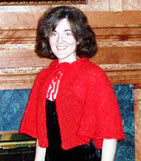
Hand Knit Capelet
Status: Generator works, but I need to add the HK schematic and code the yardage estimator based on the amount of yarn I used in my test knit cape!
 This
page has a pattern generator (aka program) to create a pattern for a
hand knit capelet, cape or collar. I am modeling a 16" log cape
to the left. I knit that from 140 grams
the most wonderful mohair imaginable. You can design your own
cape and knit it from any yarn you like. You can also enter
a very short length, and create a pattern for a collar; I'm modeling
one
to the right. Machine knitters can also create a pattern by
visiting the machine knit capelet page.
This
page has a pattern generator (aka program) to create a pattern for a
hand knit capelet, cape or collar. I am modeling a 16" log cape
to the left. I knit that from 140 grams
the most wonderful mohair imaginable. You can design your own
cape and knit it from any yarn you like. You can also enter
a very short length, and create a pattern for a collar; I'm modeling
one
to the right. Machine knitters can also create a pattern by
visiting the machine knit capelet page.
Main site, blog, Poncho & Cape collection, hats, mittens & gloves.
You must set your browser to run javascript and to accept
cookies to run this program.
Characteristics of the capelet:
- Knit from the neck down to the hem using circular needles.
- Optional 1.5" attached roll collar.
- Tied closed with Idiot-Cord.
- Garter stitch edging and front and hem.
- Short row shaping near hem to ensure front isn't longer than back.
- Short row shaping at neck to raise back neck.
- You can pick the shoulder width, neck opening size and length to fit you.
- You can enter your stitch and row gauge to get the pattern for your yarn.
- This pattern is simple, but you should be familiar with knitting short rows, and working increases. (Although, I think if you know how to handle the needles, this is a good pattern to learn both techniques You work zillions of increases first. Then you advance to short rows. )
- I
knit my red capelet using slightly less than 140 grams of mohair; the yardage was 630
meters altogether. I plan to write a yardage estimator by the
end of the week. (It's Tuesday Dec. 6 today!)
Remember: Like all patterns spit out by my generators, this is
mostly shaping directions.
The purpose of the generators is to let you be
creative, while eliminating the need to do pesky
calculations. This generator will let you make exactly the cape shown, but I encourage you to add your own touches.

